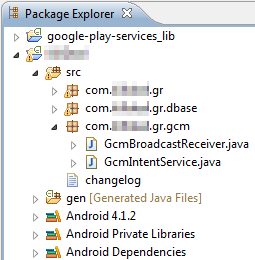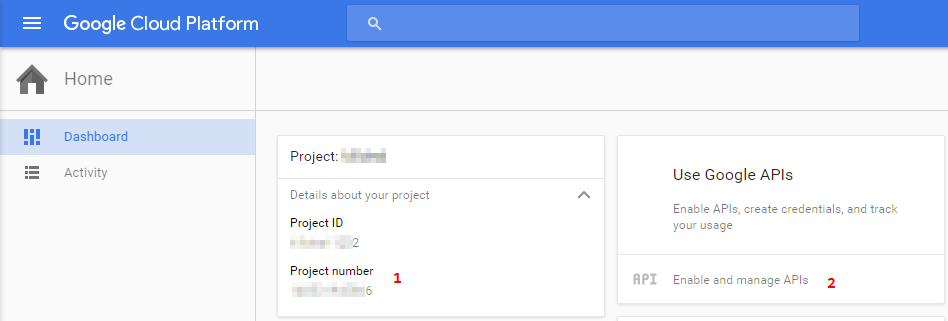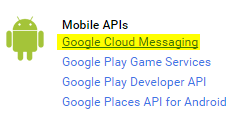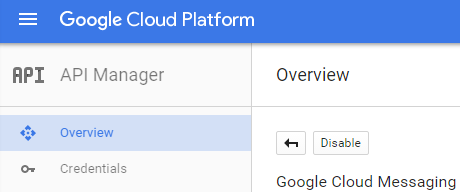Alright, I develop an application for a client, is time to implement the push notification for one more time :)
At first download the latest google-play-services which is target:android-23**, seems that has some conflicts when tried to obfuscate it (using Eclipse / Android 6.0 for compile / ant) some of the errors :
1
2
3
com.google.android.gms.internal.zzlh: can't find dynamically referenced class com.facebook.FacebookSdk
^wtf?
, whatever I restore back the target:android-16!! **Plays 100%
the steps :
1-**On androidmanifest.xml add inside application tag :
1
2
3
4
5
6
7
8
9
10
11
12
13
14
//androidmanifest.xml sample
<application android:name=".Dynomite" android:allowbackup="true" android:icon="@drawable/ic_launcher" android:label="@string/app_name" android:logo="@drawable/actionbar_logo_red" android:theme="@style/AppTheme">\
<receiver android:name="com.test.gr.gcm.GcmBroadcastReceiver" android:permission="com.google.android.c2dm.permission.SEND">
<intent-filter>
<action android:name="com.google.android.c2dm.intent.RECEIVE"></action>
<category android:name="com.test.gr"></category>
</intent-filter>
</receiver>
<service android:name="com.test.gr.gcm.GcmIntentService"></service>
</application>

then add the needed files for into separate package I will name it gcm, so we have com.text.gr.gcm
1
2
3
4
5
6
7
8
9
10
11
12
13
14
15
16
17
18
19
20
21
22
23
24
25
26
27
28
29
30
31
32
33
34
35
36
37
38
39
40
41
42
43
44
45
46
47
48
49
50
51
52
53
54
55
56
57
58
59
60
61
62
63
64
65
66
67
68
69
70
71
72
73
74
75
76
77
78
79
80
81
82
83
84
85
86
87
88
89
90
91
92
93
94
95
96
97
98
99
100
101
102
103
104
105
106
107
108
109
110
111
112
113
114
115
116
117
118
119
120
121
122
123
124
125
126
127
128
129
130
131
132
133
134
135
136
137
138
139
140
141
142
143
144
145
146
//GcmBroadcastReceiver.java
package com.test.gr.gcm;
import android.app.Activity;
import android.content.ComponentName;
import android.content.Context;
import android.content.Intent;
import android.support.v4.content.WakefulBroadcastReceiver;
/**
* This {@code WakefulBroadcastReceiver} takes care of creating and managing a
* partial wake lock for your app. It passes off the work of processing the GCM
* message to an {@code IntentService}, while ensuring that the device does not
* go back to sleep in the transition. The {@code IntentService} calls
* {@code GcmBroadcastReceiver.completeWakefulIntent()} when it is ready to
* release the wake lock.
*/
public class GcmBroadcastReceiver extends WakefulBroadcastReceiver {
@Override
public void onReceive(Context context, Intent intent) {
// Explicitly specify that GcmIntentService will handle the intent.
ComponentName comp = new ComponentName(context.getPackageName(), GcmIntentService.class.getName());
// Start the service, keeping the device awake while it is launching.
startWakefulService(context, (intent.setComponent(comp)));
setResultCode(Activity.RESULT_OK);
}
}
//GcmIntentService.java
package com.test.gr.gcm;
import android.app.IntentService;
import android.app.NotificationManager;
import android.app.PendingIntent;
import android.content.Context;
import android.content.Intent;
import android.content.SharedPreferences;
import android.graphics.BitmapFactory;
import android.media.RingtoneManager;
import android.net.Uri;
import android.os.Bundle;
import android.preference.PreferenceManager;
import android.support.v4.app.NotificationCompat;
import android.util.Log;
import com.google.android.gms.gcm.GoogleCloudMessaging;
import com.test.gr.MainActivity;
import com.test.gr.R;
/**
* This {@code IntentService} does the actual handling of the GCM message.
* {@code GcmBroadcastReceiver} (a {@code WakefulBroadcastReceiver}) holds a
* partial wake lock for this service while the service does its work. When the
* service is finished, it calls {@code completeWakefulIntent()} to release the
* wake lock.
*/
public class GcmIntentService extends IntentService {
public static final int NOTIFICATION_ID = 1;
private NotificationManager mNotificationManager;
NotificationCompat.Builder builder;
public GcmIntentService() {
super("GcmIntentService");
}
private SharedPreferences preferences;
public static final String TAG = "GCM CC";
@Override
protected void onHandleIntent(Intent intent) {
Bundle extras = intent.getExtras();
GoogleCloudMessaging gcm = GoogleCloudMessaging.getInstance(this);
// The getMessageType() intent parameter must be the intent you received
// in your BroadcastReceiver.
String messageType = gcm.getMessageType(intent);
preferences = PreferenceManager.getDefaultSharedPreferences(getBaseContext());
if (!extras.isEmpty()) { // has effect of unparcelling Bundle
/*
* Filter messages based on message type. Since it is likely that GCM will be
* extended in the future with new message types, just ignore any message types you're
* not interested in, or that you don't recognize.
*/
if (GoogleCloudMessaging.MESSAGE_TYPE_SEND_ERROR.equals(messageType)) {
Log.d(TAG, "Send error: " + extras.toString());
} else if (GoogleCloudMessaging.MESSAGE_TYPE_DELETED.equals(messageType)) {
Log.d(TAG, "Deleted messages on server: " + extras.toString());
// If it's a regular GCM message, do some work.
} else if (GoogleCloudMessaging.MESSAGE_TYPE_MESSAGE.equals(messageType)) {
// Post notification of received message.
String title = extras.getString("title", null);
String message = extras.getString("description", null);
String link = extras.getString("link", null);
sendNotification(title, message, link);
Log.i(TAG, "Received: " + extras.toString());
}
}
// Release the wake lock provided by the WakefulBroadcastReceiver.
GcmBroadcastReceiver.completeWakefulIntent(intent);
}
// Put the message into a notification and post it.
// This is just one simple example of what you might choose to do with
// a GCM message.
private void sendNotification(String title, String msg, String link) {
mNotificationManager = (NotificationManager)
this.getSystemService(Context.NOTIFICATION_SERVICE);
Intent intent = new Intent(this, MainActivity.class);
intent.putExtra("link", link);
PendingIntent contentIntent = PendingIntent.getActivity(this, 0, intent, PendingIntent.FLAG_CANCEL_CURRENT);
NotificationCompat.Builder mBuilder = new NotificationCompat.Builder(this)
.setLargeIcon(BitmapFactory.decodeResource(getBaseContext().getResources(), R.drawable.ic_launcher))
.setSmallIcon(R.drawable.ic_launcher)
.setContentTitle(title)
.setStyle(new NotificationCompat.BigTextStyle()
.bigText(msg))
.setContentText(msg);
// Set the notification vibrate option
if (preferences.getBoolean("notifications_new_message_vibrate", true)) {
mBuilder.setVibrate(new long[]{1000, 1000, 1000, 1000, 1000});
}
// Set the notification ringtone
if (preferences.getString("notifications_new_message_ringtone", null) != null) {
mBuilder.setSound(Uri.parse(preferences.getString("notifications_new_message_ringtone", null)));
} else {
Uri alarmSound = RingtoneManager.getDefaultUri(RingtoneManager.TYPE_NOTIFICATION);
mBuilder.setSound(alarmSound);
}
// Show only if the notification are enabled
if (preferences.getBoolean("notifications_new_message", true)) {
mBuilder.setContentIntent(contentIntent);
mNotificationManager.notify(NOTIFICATION_ID, mBuilder.build());
}
}
}
On your mainactivity (does matter if your application has a splashscreen, this will be added to mainactivity)
1
2
3
4
5
6
7
8
9
10
11
12
13
14
15
16
17
18
19
20
21
22
23
24
25
26
27
28
29
30
31
32
33
34
35
36
37
38
39
40
41
42
43
44
45
46
47
48
49
50
51
52
53
54
55
56
57
58
59
60
61
62
63
64
65
66
67
68
69
70
71
72
73
74
75
76
77
78
79
80
81
82
83
84
85
86
87
88
89
90
91
92
93
94
95
96
97
98
99
100
101
102
103
104
105
106
107
108
109
110
111
112
113
114
115
116
117
118
119
120
121
122
123
124
125
126
127
128
129
130
131
132
133
134
135
136
137
//MainActivity.java
// GCM
public static final String PROPERTY_REG_ID = "notifyId";
private static final String PROPERTY_APP_VERSION = "1";
GoogleCloudMessaging gcm;
SharedPreferences preferences;
String reg_cgm_id;
static final String TAG = "MainActivity";
@Override
protected void onCreate(Bundle savedInstanceState) {
.
.
// //////////////////////////////////////////////////////////////
// GCM -
if (checkPlayServices()) {
gcm = GoogleCloudMessaging.getInstance(getApplicationContext());
String reg_cgm_id = getRegistrationId(getApplicationContext());
Log.i(TAG, "Play Services Ok.");
if (reg_cgm_id == null || reg_cgm_id.isEmpty()) {
Log.i(TAG, "Find Register ID.");
registerInBackground();
}
} else {
Log.i(TAG, "No valid Google Play Services APK found.");
}
}
/**
* Check the device to make sure it has the Google Play Services APK. If it
* doesn't, display a dialog that allows users to download the APK from the
* Google Play Store or enable it in the device's system settings.
*/
private boolean checkPlayServices() {
int resultCode = GooglePlayServicesUtil.isGooglePlayServicesAvailable(MainActivity.this);
if (resultCode != ConnectionResult.SUCCESS) {
if (GooglePlayServicesUtil.isUserRecoverableError(resultCode)) {
GooglePlayServicesUtil.getErrorDialog(resultCode, this, 9000).show();
} else {
Log.i(TAG, "This device is not supported.");
}
return false;
}
return true;
}
/**
* Gets the current registration ID for application on GCM service.
* If result is empty, the app needs to register.
*/
private String getRegistrationId(Context context) {
String registrationId = General.get_pref(this).getString(PROPERTY_REG_ID, "");
if (registrationId.isEmpty()) {
Log.i(TAG, "Registration not found.");
return "";
}
// Check if app was updated; if so, it must clear the registration ID
// since the existing regID is not guaranteed to work with the new
// app version.
int registeredVersion = General.get_pref(this).getInt(PROPERTY_APP_VERSION, Integer.MIN_VALUE);
int currentVersion = getAppVersion(context);
if (registeredVersion != currentVersion) {
Log.i(TAG, "App version changed.");
return "";
}
return registrationId;
}
/**
* Registers the application with GCM servers asynchronously.
*/
private void registerInBackground() {
new AsyncTask<void, void,="" string="">() {
@Override
protected String doInBackground(Void... params) {
String msg = "";
try {
if (gcm == null) {
gcm = GoogleCloudMessaging.getInstance(MainActivity.this);
}
reg_cgm_id = gcm.register("**you project number**");
msg = "Device registered, registration ID=" + reg_cgm_id;
Log.d(TAG, "ID GCM: " + reg_cgm_id);
// You should send the registration ID to your server
sendRegistrationIdToBackend();
} catch (IOException ex) {
msg = "Error :" + ex.getMessage();
}
return msg;
}
@Override
protected void onPostExecute(String msg) {
}
}.execute(null, null, null);
}
/**
* Stores the registration ID and the app versionCode in the application SharedPreferences
*/
private void storeRegistrationId(Context context, String regId) {
int appVersion = getAppVersion(context);
Log.i(TAG, "Saving regId on app version " + appVersion);
SharedPreferences.Editor editor = General.get_pref(this).edit();
editor.putString(PROPERTY_REG_ID, regId);
editor.putInt(PROPERTY_APP_VERSION, appVersion);
editor.commit();
}
/**
* Sends the registration ID to your server
*/
private void sendRegistrationIdToBackend() {
//your own implementation to send the current device token (stored to public var reg_cgm_id) to your web server
//only when server got it, call the
storeRegistrationId(MainActivity.this, reg_cgm_id);
}
/**
* @return Application's version code from the {@code PackageManager}.
*/
private static int getAppVersion(Context context) {
try {
PackageInfo packageInfo = context.getPackageManager().getPackageInfo(context.getPackageName(), 0);
return packageInfo.versionCode;
} catch (PackageManager.NameNotFoundException e) {
// should never happen
throw new RuntimeException("Could not get package name: " + e);
}
}
proguard rules
1
2
3
4
5
6
7
8
9
10
11
12
13
14
15
16
17
18
19
20
21
22
23
24
25
26
27
28
//google-play-services_lib -- proguard-project.txt
-dontskipnonpubliclibraryclassmembers
-keep class * extends java.util.ListResourceBundle {
protected Object[][] getContents();
}
# Keep SafeParcelable value, needed for reflection. This is required to support backwards
# compatibility of some classes.
-keep public class com.google.android.gms.common.internal.safeparcel.SafeParcelable {
public static final *** NULL;
}
# Keep the names of classes/members we need for client functionality.
-keepnames @com.google.android.gms.common.annotation.KeepName class *
-keepclassmembernames class * {
@com.google.android.gms.common.annotation.KeepName *;
}
# Needed for Parcelable/SafeParcelable Creators to not get stripped
-keepnames class * implements android.os.Parcelable {
public static final ** CREATOR;
}
//com.test.gr -- proguard-project.txt
# Keel all googleclasses
-keep class com.google.** { *; }
-dontwarn com.google.**
the steps for Google Cloud Platform
you go to https://console.cloud.google.com/, create a project, this project will taken a Project Number** write it down!

goto Enable and manage APIs** select the Mobile > Cloud messaging and enable it! 

click credentials on ^left and create a server or browser key 
I dont use the Domain Verification tab, I went to https://www.google.com/webmasters/tools/home click add property and verify by html file, my domain. In this way I can use Server and Browser keys….
at the time of the article 3/4/2016, my old application (https://www.pipiscrew.com/works/gcm-push-tested/), works, but send empty message on the device : 
but lets
implement the PHP version!
1
2
3
4
5
6
7
8
9
10
11
12
13
14
15
16
17
18
19
20
21
22
23
24
25
26
27
28
29
30
31
32
33
34
35
36
37
38
39
40
41
42
43
44
45
46
47
48
49
50
51
52
53
54
55
56
57
58
59
60
61
62
63
64
65
66
67
68
69
70
71
72
73
74
75
76
77
78
79
80
81
82
83
84
85
86
87
88
89
90
91
92
93
94
95
96
97
98
99
100
101
102
103
104
105
106
107
108
109
110
111
112
113
114
115
116
117
118
119
120
121
122
123
124
125
126
127
128
129
130
131
132
133
134
135
136
137
138
139
140
141
142
143
144
145
146
147
148
149
150
151
152
153
154
155
156
157
158
159
160
161
162
163
164
165
166
167
168
169
170
171
//index.php
<?php if="" ($_server['request_method']="==" 'post')="" {="" $password_string="mysql_escape_string($_POST[" password"]);"="" if="" ($password_string!="yourpasswordhere" )="" doesnt="" compare="" the="" mail="" {="" die("error!");="" }="" else="" {="" show="" the="" rest!="" }="" }="" else="" {="" login="" system=""?>
<style>
body {
padding-top: 40px;
padding-bottom: 40px;
background-color: #eee;
}
.form-signin {
max-width: 330px;
padding: 15px;
margin: 0 auto;
}
.form-signin .form-signin-heading,
.form-signin .checkbox {
margin-bottom: 10px;
}
.form-signin .checkbox {
font-weight: normal;
}
.form-signin .form-control {
position: relative;
height: auto;
-webkit-box-sizing: border-box;
-moz-box-sizing: border-box;
box-sizing: border-box;
padding: 10px;
font-size: 16px;
}
.form-signin .form-control:focus {
z-index: 2;
}
.form-signin input[type="email"] {
margin-bottom: -1px;
border-bottom-right-radius: 0;
border-bottom-left-radius: 0;
}
.form-signin input[type="password"] {
margin-bottom: 10px;
border-top-left-radius: 0;
border-top-right-radius: 0;
}
</style>
<div class="container">
<form class="form-signin" method="POST" action="">
## Please sign in
<label for="mail" class="sr-only">Email address</label>
<input type="email" name="mail" class="form-control" placeholder="Email address" required="" autofocus="">
<label for="password" class="sr-only">Password</label>
<input type="password" name="password" id="password" class="form-control" placeholder="Password" required="">
<button class="btn btn-lg btn-primary btn-block" type="submit">Sign in</button>
</form>
</div>
<?php exit;="" }=""?>
<div class="container">
<div class="header clearfix">
### Test - Push Panel
</div>
<div class="jumbotron">
# Send a push notification
<form role="form" action="push_users.php" method="post">
<div class="form-group">
<label for="title">Title:</label>
<input type="text" name="title" class="form-control" id="title">
</div>
<div class="form-group">
<label for="msg">Message:</label>
<input type="text" name="message" class="form-control" id="msg">
</div>
<button type="submit" class="btn btn-primary">Send now</button>
</form>
</div>
</div>
//push_users.php
<?php date_default_timezone_set("utc");="" if="" (!$_post)="" die("use="" only="" post="" please");="" if(!isset($_post["title"])="" ||="" !isset($_post["message"]))="" die("no="" valid="" variables");="" require_once="" ('config.php');="" try="" {="" $db="connect_mysql();" }="" catch="" (exception="" $e)="" {="" die($e-=""?>getMessage());
}
$title = $_POST['title'];
$msg = $_POST['message'];
class GCM {
function __construct(){}
public function send_notification($registatoin_ids,$data) {
// GOOGLE API KEY
define("GOOGLE_API_KEY","your_server_key");
$url="https://android.googleapis.com/gcm/send";
$fields=array(
"registration_ids"=>$registatoin_ids,
"data"=>$data,
);
//var_dump($fields);
$headers=array(
"Authorization: key=".GOOGLE_API_KEY,
"Content-Type: application/json"
);
$ch=curl_init();
curl_setopt($ch,CURLOPT_URL,$url);
curl_setopt($ch,CURLOPT_POST,true);
curl_setopt($ch,CURLOPT_HTTPHEADER,$headers);
curl_setopt($ch,CURLOPT_RETURNTRANSFER,true);
curl_setopt($ch,CURLOPT_SSL_VERIFYPEER,false);
curl_setopt($ch,CURLOPT_POSTFIELDS,json_encode($fields));
$result_gcm=curl_exec($ch);
if($result_gcm===FALSE){
die("Curl failed: ".curl_error($ch));
}
curl_close($ch);
var_dump($result_gcm); //for debug
}
}
//get user tokens by dbase records
$tokens = getSet($db,"select push_reg_id from users where push_reg_id IS NOT NULL",null);
if (!$tokens)
die("there is no records");
$android_tokens = array();
$x=0;
foreach($tokens as $tok) {
$android_tokens[] = $tok["push_reg_id"];
$x++;
}
if ($android_tokens != array()) {
$gcm=new GCM();
$data=array("title"=>$title,"description"=>$msg,"link"=>$link);
$result_android=$gcm->send_notification($android_tokens,$data);
}
?>
<div class="container">
<div class="header clearfix">
### Test - Push Panel
</div>
<div class="jumbotron">
# Good!
You have sent <?php echo="" $x;?=""?> push notification.
</div>
</div>
source - http://iconhandbook.co.uk/reference/chart/android/
origin - http://www.pipiscrew.com/?p=4720 android-push-notification
